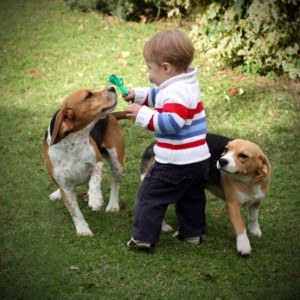Do you know what warning signs to look for when supervising your dog?
“Supervise your dogs and children when they are together, never leave them alone.”
I think we can all agree that is pretty sound advice. But when adults are supervising the children and dogs, what are they looking for? An estimated 800,000 Americans seek medical attention for dog bites each year. Half of those victims are children ages 5-9.
The blame can’t be placed on negligent parents or their dogs. The dogs doing the biting are not pit bulls or rottweilers. In fact, Dachsunds bite the most often! We know they are supervising, and we know your dog is well trained. Perhaps the problem is that not enough people are knowledgeable in what to be watching for when your furry friends are playing with children. We want to help you recognize the signs your dog is giving in regard to their comfort level. By knowing what behaviors are warning signals, you’ll have a better chance and intervening before the dog resorts to a bite.
First of all, look at your pup’s body language. Safe dog body language can be described as loose. Comfortable dogs are relaxed, and their body is wiggly. Look for curves in their body as they play. You dog’s body language will stiffen, tighten or freeze when she is uncomfortable. Something else to look for is panting behavior. If the dog suddenly stops panting, as if holding their breath, it is a sign they are tense.
Pay attention to the child’s behavior toward the dog. Do not let children climb on your dog or attempt to ride her. Just as you prefer to be treated gently, poking and prodding a dog can irritate them and cause them to lash out. Teach your child that those behaviors are an unacceptable way to play with the family pet.
It’s easy to overlook obvious gestures indicating stress if you don’t know what to look for in your dog. Yawning and lip licking may seem normal, but out of context, they can have a different meaning.
Look for these easy to spot but often overlooked stress gestures:
-Yawning outside the context of waking up, or being sleepy.
-Half-moon eye (you are able to see the whites on the outer edges of the dog’s eye)
-Lip licking outside the context of eating food
Watch for avoidance behaviors exhibited by your dog. Just like humans, if something is unpleasant, dogs will try to avoid it. If you dogs moves away from the child, keep the child from following. A dog that moves away is exhibiting a gesture that says, “I’m not really in the mood so I’ll go away.” Make sure to support the “I’ll go away” gesture. Intervene if the child follows. That will help keep the dog from resorting to growling, snapping or biting to get away.
Finally, listen for growling. While this may seem like an obvious gesture, it’s easy to get into the habit of accepting your dog’s growling as just that and nothing more. Aggressive dog behavior is on a continuum. Growling is a warning sign of aggression. When growing doesn’t work, a dog is likely to escalate to snapping or biting. Growling should be a natural indication that you should step in and intervene.
In addition to watching for these behaviors during doggie playtime, make an effort to teach the children to recognize the behavioral warning signs their four legged friend is trying to send them.
Please share this information so that others know what warning signs to look for when supervising their dogs.
